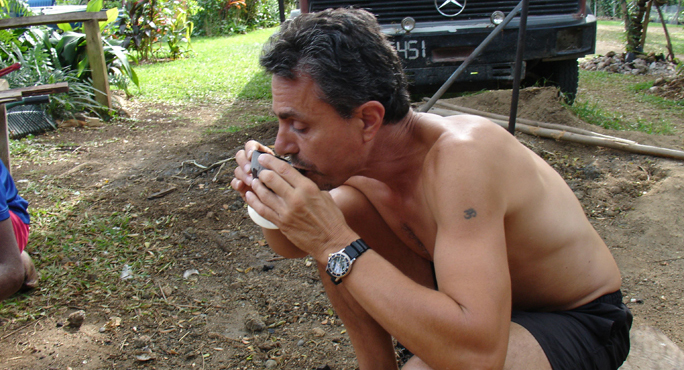
Chris drinking Kava in Vanuatu
As a medicine hunter, Chris Kilham has performed traditional Polynesian firewalks, narrowly escaped death, been greeted at spear-point, chased by pirates, and consumed hallucinogenic potions in shamanic ceremonies, all in a day’s work exploring Nature’s healing secrets. Amidst spear-wielding natives, eccentric explorers, daring botanists and mammoth corporations, Chris works to sustainably reap nature’s rich bounty of medicines, from the rainforests of the Amazon to the Himalayan hills. In this entertaining, information-packed seminar we’ll explore how beneficial plants become natural and pharmaceutical medicines, and what happens to native people, the environment, and the plants themselves along the way. CNN calls Chris “The Indiana Jones of Natural Medicine.
How do you get started in ethnobotany?
I was a hippie in the sixties and it just sorta happened. I was hooked on traveling so I wanted to dream up a job that would allow me to get paid to travel. About 13 years ago, I got a chance to go to China for a project and while I was there I said to myself, I can do this, and I can do it better. Soon after I hooked up with a company that wanted me to develop their herbal product line, one thing led to another and I was traveling around the world.
I work in the field of plant medicine. Plant-based medicine is accepted world wide and heavily researched. I’m under the belief that death is an unacceptable drug reaction. If anyone says “It’s not personal, it’s business” …that’s not ok with me, and it shouldn’t be with you. All business is personal all the time.
What is your definition of a Shaman?
A good shaman is a person with such power that they can transport you as a person from this physical world into the spiritual world. It’s important to find a shaman that knows what he/she is doing because there are plenty of others out there that don’t have the skills. One of the best shaman I ever met was a very very small (70 lbs, maybe) 103 year old Peruvian woman. She didn’t actually know me, what I did or where I cam from, but she seemed to know a lot about me. She said “You bridge the worlds, you tell people about each other, this is important.” I realized I could b the communicator between cultures, reduce inhuman ways of thinking. Without telling tell me what she was doing, she touched me in various places similar to chakras and over the next 24 hours I felt like I was burning from the inside. About 3 in the morning, my “fever” broke and I felt more powerful than I ever have.
Segway to Firewalking: how does it work?
I don’t know. Do people get burned? You bet. Abandon yourself, throw yourself into something completely, it’s the times.
Is it sustainable to collect the herbs in the Amazon or where ever?
The people in the remote territories where the herbs grow are eager to make money off their resources so that they can survive and not have to move off their land. It’s much better than selling their land to the logging companies!
But what about “over” wildcrafting, depleting the resources?
I work with teams who teach the native people to collect only what is available to not deplete the sources, allowing for regeneration of the herb. This is ethical wildcrafting and honors the plant by allowing it to reproduce itself indefinitely.
FOUR IMPORTANT PLANTS THAT EVERYONE SHOULD KNOW ABOUT
Kava (Piper methysticum):
Has anyone here experienced anxiety? (big show of hands, and laughter). Kava is a hugh anti-anxiety herb. It comes from mostly Indonesia and also grows wild in Hawaii. In cultural situations, it has it’s own time of day…what time is it? “It’s Kava time.” Everyone stops their work. It’s pounded into a drink and drunk together, not alone, it’s happy hour without the alcohol. Then they all go home, spend time with their families, and sleep well. Kava is used for dispute resolution, kind of like a truth serum. After drinking the Kava, the relaxation sets in and you may say “I think I owe you some chickens”. You cannot hate with kava in you.
Maca (Lepidium meyenii): A Peruvian plant that looks like a turnip, a staple food in the Andes. It is a super food plus it’s side benefit is an awesome sex drive. Does anyone here like to have good sex drive? (a lot of giggling) If you give animals Maca, all they do is screw all, not a bad existence. I’m always working with the shamans, because they do what they’re doing and they are connected to the land.
Rhodiola rosea (Rhodiola rosea): In China, Rhodiola is grown at high altitude about 10,000 feet and can only be collected during 2 months of the year. It has a profound anti-depressant quality, works better than placebos, and is without any side effects. This “gateway herb” may give you that profound experience of feeling good. So many people feel crappy today, so this can make you feel good. This is how the herb trade happens, it’s millions of small growers and collectors, it’s not big plantations. Fun fact: Americans consume 70% of the world’s anti-depressants.
Cat’s Claw (Uncaria tomentosa): Cat’s Claw is an amazonian plant. Cat’s Claw also has a profound effect on the immune system, and has had proven effects on anti-cancer. All degenerative disease involves inflammation, anything that ends in “-itis”, ie arthritus, pancreatitis, etc. Drug development is driven by patent law. Even I travel with Cipro, just in case I get a bad infection. We call bad effects, a “side” effect, but it’s still an effect, why is it a side? One of the best anti-inflammatory herbs, that by the way can’t be patented, is Cat’s Claw. The amazon forest produces 20% of the world’s oxygen, we need to save it, we all like to breathe way too much.

